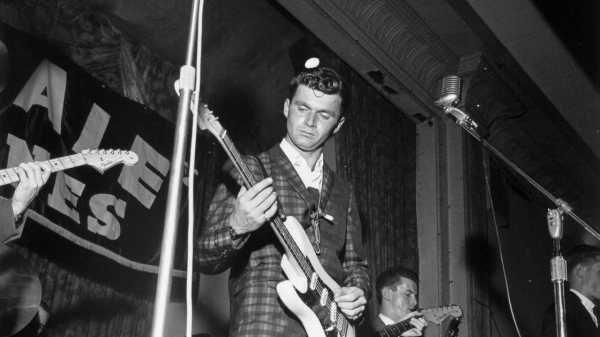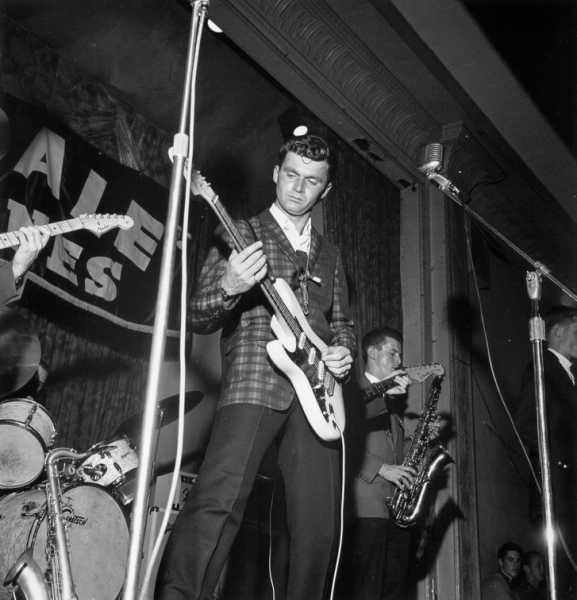

Dick Dale’s work was directly and mightily informed by the Arabic music that he listened to as a child.
Photograph from Michael Ochs Archives / Getty
Like a lot of people in my generation, I heard Dick Dale’s “Misirlou” for the first time in the opening credits of Quentin Tarantino’s “Pulp Fiction.” It was 1994, I was fourteen, and my friend Bobby, who had both a license and a car, had driven us to the fancy movie theatre, the one with the un-ripped seats and slightly artier films. We were aspiring aesthetes who dreamed of one day being described as pretentious; by Thanksgiving, we had made half a dozen trips to see “Pulp Fiction.” Each time “Miserlou” played—and Tarantino lets it roll on, uninterrupted, for over a minute—I gripped my cardboard tub of popcorn a little tighter. I simply could not imagine a cooler way to start a movie. “Misirlou” is only two minutes and fifteen seconds long, all told, but it communicates an extraordinary amount of menace. Dale yelps periodically, as if he’s being hotly pursued. One is left only with the sense that something terrible and great is about to occur.
Dale died on Saturday, at age eighty-one. It’s perhaps curious, at first glance, that a Lebanese-American kid from Boston invented a genre known as surf rock, but such is Dale’s story. He was born Richard Monsour in 1937; several decades earlier, his paternal grandparents had immigrated to the U.S. from Beirut. Dale bought his first guitar used, for eight dollars, and paid it off twenty-five or fifty cents at a time. He liked Hank Williams’s spare and searching cowboy songs—his stage name is a winking homage to the cheekiness of the country-music circuit—but he was particularly taken by the effervescent and indefatigable drumming of Gene Krupa. His guitar style is rhythmic, prickly, biting: “That’s why I play now with that heavy staccato style like I’m playing drums,” he told the Miami New Times, in 2018. “I actually started playing on soup cans and flower pots while listening to big band.” When he was a senior in high school, his family moved from Massachusetts to El Segundo, California, so that his father, a machinist, could take a job at Howard Hughes’s aerospace company. That’s when Dale started surfing.
As far as subgenres go, surf rock is fairly specialized: the term refers to instrumental rock music made in the first half of the nineteen-sixties, in southern California, in which reverb-laden guitars approximate, in some vague way, the sound of a crashing wave. Though it is tempting to fold in bands like the Beach Boys, who often sang about surfing, surf rock was wet and gnarly and unconcerned with romance or sweetness. The important part was successfully evincing the sensation of riding atop a rushing crest of water and to capture something about that experience, which was both tense and glorious: man versus sea, man versus himself, man versus the banality and ugliness of life on land. Its biggest question was: How do we make this thing sound the way that thing feels? Surfing is an alluring sport in part because it combines recklessness with grace. Dale’s music did similar work. It was as audacious as it was beautiful.
For six months, beginning on July 1, 1961, Dale set up at the Rendezvous Ballroom, an old dance hall on the Balboa Peninsula, in Newport Beach, and tried to bring the wildness of the Pacific Ocean inside. His song “Let’s Go Trippin’,” which he started playing that summer, is now widely considered the very first surf-rock song. He recorded it in September, and it reached No. 60 on the Hot 100. His shows at the Rendezvous were often referred to as stomps, and they routinely sold out. It is hard not to wonder now what it must have felt like in that room: the briny air, a bit of sand in everyone’s hair, Dale shredding so loud and so hard that the windows rattled. He was messing around with reverb and non-Western scales, ideas that had not yet infiltrated rock music in any meaningful way. Maybe you took a beer outside and let his guitar fade into the sound of the surf. Maybe you stood up close, near a speaker, and felt every bone in your body clack together.
Dale’s work was directly and mightily informed by the Arabic music that he listened to as a child. “My music comes from the rhythm of Arab songs,” Dale told the journalist George Baramki Azar, in 1998. “The darbukkah, along with the wailing style of Arab singing, especially the way they use the throat, creates a very powerful force.”
Dale was left-handed, and he preferred to play a custom-made Fender Stratocaster guitar at an indecent volume. (After he exploded enough amplifiers, Fender also made him a custom amplifier—the Dick Dale Dual Showman.) His version of “Misirlou” is gorgeously belligerent. Though it feels deeply American—it is so heavy with the energy of teen-agers, hot rods, and wide suburban boulevards—“Misirlou” is in fact an eastern Mediterranean folk song. The earliest recorded version is Greek, from 1927, and it was performed in a style known as rebetiko, itself a complex mélange of Orthodox chanting, indigenous Greek music, and the Ottoman songs that took root in Greek cities during the occupation. (A few years back, I spent some time travelling through Greece for a Times Magazine story about indigenous-Greek folk music; when I heard “Misirlou” playing from a 78-r.p.m. record on a gramophone on the outskirts of Athens—a later, slower version, recorded by an extraordinary oud player named Anton Abdelahad—I nearly choked on my cup of wine.)
That a song written at least a century before and thousands of miles away could leave me quaking in a movie theatre in suburban New York City in 1994 is so plainly miraculous and wonderful—how do we not toast Dale for being the momentary keeper of such a thing? He eventually released nine studio albums, beginning in 1962 and ending in 2001. (In 2019, he was still touring regularly and had new dates scheduled for this spring and summer.) There’s some footage of Dale playing “Misirlou” on “Later…with Jools Holland,” in 1996, when he was nearly sixty years old. His hair has thinned, and he’s wearing a sweatband across his forehead. A feathery earring hangs from one ear. The dude is going for it in a big way. It feels like a plume of smoke is about to start rising from the strings of his guitar. His fingers never stop moving. It’s hard to see the faces of the audience members, but I like to think that their eyes were wide, and they were thinking of the sea.
Sourse: newyorker.com






